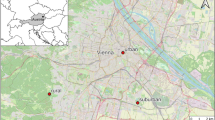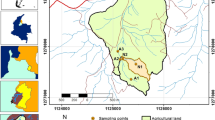Abstract
Animals have a significant impact on the territory where they live by the process of their lives. The studied objects are located in the zone of dry steppes, where climatic conditions limit the development of vegetation and contribute to changes in soil characteristics, which, in combination with the impact of animals, enhances the effect. The purpose of the work was to assess the impacts of animals on the ecological state of the soils of the enclosures of the Wildlife of the Steppe Association. In the course of the study, the main indicators of the ecological state of soils in enclosures with animals on the territory of the enclosures of the Wildlife of the Steppe Association in the arid regions of the Rostov region were determined. We explored enclosures of different sizes, with African ostriches (Struthio camelus), emu (Dromaius novaehollandiae), goats (Capra sp.), Przewalski’s horses (Equus ferus przevwalskii) and saigas (Saiga tatarica), and on the territory with semi-free grazing of ungulates, that is, horses (Equus caballus), camels (camelus bactrianus), buffaloes (Bubalus arnee), yaks (Bos mutus), and lamas (Lama ganicoe). The studied areas differed in the intensity of soil degradation. To assess the physical condition the moisture, temperature, density, and structure of the soil were determined; pH, the gross chemical composition of soils, humus content, and biological activity were also assessed, and plots were ranked according to the degree of pasture digression. In the course of the study, the enclosure with African ostriches had the maximum degree of degradation of ten, which is characterized by severe inhibition of vegetation and soil degradation. As well, the soil density in the enclosure with African ostriches was the highest, 1.49 g/cm3, and the percentage of structure was the smallest, 37%. These parameters had a close negative correlation with the pressure of the animals' hooves and paws on the ground (–0.9). The humidity level in the studied areas did not rise above 11%; despite this, the enzymatic activity of the soils no longer depended on hydrothermal conditions, but on the influence of excretions of animal waste products. In enclosures with ungulates, in particular in the enclosure with goats, the activities of catalase and urease were always higher than in other areas. A high content of humus, 10.3%, was also noted there, which is uncharacteristic for chestnut soils and confirms the influence of animal life on them. According to the research results, the lowest quality of the structure, humus, and biological activity, as well as increased soil density, occurred in the enclosure with the African ostrich. The data we obtained explain the decrease in the growth and development of vegetation in the area where animals kept in crowded conditions live.




Similar content being viewed by others
Notes
Latin names of plants are given according to the work of S.K. Cherepanov (1995).
Latin names of animals are given on the site Systematic list of the collection of animals of the Rostov-on-Don Zoo (2022).
REFERENCES
Association “Wildlife of the Steppe”, 2022. https://xn-80ahejd6affdbom.xn-p1ai/zhivaya-priroda-stepi/. Cited February 11, 2022.
Chen, J., Shao, C., Jiang, S., Qu, L., Zhao, F., and Dong, G., Effects of changes in precipitation on energy and water balance in a Eurasian meadow steppe, Ecol. Processes, 2019, vol. 8, no. 1, pp. 1–15.
Cherepanov, S.K., Sosudistye rasteniya Rossii i sopredel’nykh gosudarstv (v predelakh byvshego SSSR) (Vascular Plants of Russia and Neighboring Countries (Within the Former USSR)), St. Petersburg: Mir i Sem’ya, 1995. Dzhapova, V.V., Bembeeva, O.G., Ayusheva, E.Ch., Kazmin, V.D., Dzhapova, R.R., and Abaturov, B.D., Forage selectivity of semi-free-roaming bison (bison bison) in sod-forming cereal steppes in the Western Manych river valley, Arid Ecosyst., vol. 10, no. 4, pp. 305–311.
Ganieva, S.A., Dyunyamalieva, N.Ya., and Ramazanova, F.M., Grazing effect on soil properties in dry subtropic steppes of Azerbaijan, Arid Ecosyst., 2019, vol. 9, no. 3, pp. 174–178.
Garcia-Franco, N., Martínez-Mena, M., Goberna, M., and Albaladejo, J., Changes in soil aggregation and microbial community structure control carbon sequestration after afforestation of semiarid shrublands, Soil Biol. Biochem., 2015, vol. 87, pp. 110–121.
Gobarova, A.A., Zhadobin, A.V., Kazeev, K.Sh., Fedorenko, A.N., and Kolesnikov, S.I., Comparative evaluation of methods in monitoring soil in volleyers of Rostov-On-Don zoo, Izv. Vyssh. Uchebn. Zaved., Sev.-Kavk. Reg., Estestv. Nauki, 2020, no. 3(207), pp. 91–97.
Grishina, L.A. and Orlov, D.S., The system of indicators of the humus state of soils, in Problemy Pochvovedeniya (Problems of Soil Science), Moscow, 1978, pp. 42–47.
Hoffmann, C., Funk, R., Li, Y., and Sommer, M., Effect of grazing on wind driven carbon and nitrogen ratios in the grasslands of inner Mongolia, Catena, 2008, vol. 75, no. 2, pp. 182–190.
Kaz’min, V.D., Abaturov, B.D., Demina, O.N., and Kolesnikov, M.P., Food resources and nutrition of American bison (Bison bison) on the steppe pasture of the Western Manych valley, Zool. Zh., 2016, vol. 95, no. 2, pp. 234–244.
Kazeev, K.Sh., Val’kov, V.F., and Kolesnikov, S.I., Atlas pochv Yuga Rossii (Soil Atlas of the South of Russia), Rostov on Don: “Everest”, 2010.
Kazeev, K.Sh., Kolesnikov, S.I., Akimenko, Yu.V., and Dadenko, E.V., Metody biodiagnostiki nazemnykh ekosistem (Methods for Biodiagnostics of Terrestrial Ecosystems), Rostov-on-Don: YuFU, 2016.
Kazeev, K., Zhadobin, A., Gobarova, A., Fedorenko, A., and Kolesnikov, S., Assessment of ecological state of Rostov zoo soil, Eurasian J. Soil Sci., 2021, vol. 10, no. 2, pp. 87–95.
Khaziev, F.Kh., Ecological relations of the enzymatic activity of soil, Ekobiotekh, 2018, no. 1 (2), pp. 80–92.
Levi, E.M., Archer, S.R., Throop, H.L., and Rasmussen, C., Soil-litter mixing promotes decomposition and soil aggregate formation on contrasting geomorphic surfaces in a shrub-invaded Sonoran Desert grassland, Plant Soil, 2020, vol. 450, no. 1, pp. 397–415.
Lu, M., Yang, M., Yang, Y., Wang, D., and Sheng, L., Soil carbon and nutrient sequestration linking to soil aggregate in a temperate fen in Northeast China, Ecol. Indic., 2019, vol. 98, pp. 869–878.
Marinari, S., Mancinelli, R., Campiglia, E., and Grego, S., Chemical and biological indicators of soil quality in organic and conventional farming systems in Central Italy, Ecol. Indic., 2006, vol. 6, no. 4, pp. 701–711.
Menon, M., Mawodza, T., Rabbani, A., Blaud, A., Lair, G.J., Babaei, M., and Banwart, S., Pore system characteristics of soil aggregates and their relevance to aggregate stability, Geoderma, 2020, vol. 366, p. 114259.
Parwada, C. and Van Tol, J., Effects of litter quality on macroaggregates reformation and soil stability in different soil horizons, Environment, Development and Sustainability, 2019, vol. 21, no. 3, pp. 1321–1339.
Ramenskii, L.G., Tsatsenkin, I.A., Chizhikov, O.N., and Antipin, N.A., Ekologicheskaya otsenka kormovykh ugodii po rastitel’nomu pokrovu (Ecological Assessment of Fodder Lands by Vegetation Cover), Moscow: Gos. Izd. S.-Kh. Literatury, 1956.
Rusanov, A.M., Soil as a factor of vegetation regeneration in natural pastures, Russ. J. Ecol., 2011, no. 42, pp. 30–37.
Sarker, J.R., Singh, B.P., Cowie, A.L., Fang, Y., Collins, D., Badgery, W., and Dalal, R.C., Agricultural management practices impacted carbon and nutrient concentrations in soil aggregates, with minimal influence on aggregate stability and total carbon and nutrient stocks in contrasting soils, Soil Tillage Res., 2018, vol. 178, pp. 209–223.
Steffens, M., Kölbl, A., Totsche, K.U., and Kögel-Knabner, I., Grazing effects on soil chemical and physical properties in a semiarid steppe of Inner Mongolia (PR China), Geoderma, 2008, vol. 143, nos. 1–2, pp. 63–72.
Systematic list of the animal collection of the Rostov-on-Don Zoo, 2022. www.zoopark-rostov.ru/index.php/ novosti-i-sobytiya/2-uncategorised/200-kollektsiya-zooparka. Cited January 14. 2023.
Val’kov, V.F., Eliseeva, N.V., Imgrunt, I.I., Kazeev, K.Sh., and Kolesnikov, C.I., Spravochnik po otsenke pochv (Soil Assessment Handbook), Maikop: GURIPP “Adygeya”, 2004.
Vlasenko, M.V., Kulik, A.K., and Salugin, A.N., Evaluation of the Ecological Status and Loss of Productivity of Arid Pasture Ecosystems of the Sarpa Lowland, Arid Ecosyst., 2019, vol. 9, no. 4, pp. 273–281.
Wiesmeier, M., Steffens, M., Kolbl, A., and Kogel-Knabner, I., Degradation and small-scale spatial homogenization of topsoils in intensively-grazed steppes of Northern China, Soil Tillage Res., 2009, vol. 104, no. 2, pp. 299–310.
Xiao, L., Liu, G., Li, P., Li, Q., and Xue, S., Ecoenzymatic stoichiometry and microbial nutrient limitation during secondary succession of natural grassland on the Loess Plateau, China, Soil Tillage Res., 2020, vol. 200, p. 104605.
Yurkova, N.E., Yurkov, A.M., and Smagin, A.V., Ecological status of soils in Moscow Zoo, Eurasian Soil Sci., 2009, vol. 42, no. 3, pp. 342–348.
Zhadobin, A.V., Kazeev, K.S., and Kolesnikov, S.I., Influence of ameliorants on soil respiration of volleyers of the Rostov zoo, Indian J. Ecol., 2020, vol. 47, no. 4, pp. 979–983.
Zhao, F.Z., Fan, X.D., Ren, C.J., Zhang, L., Han, X.H., Yang, G.H., and Doughty, R., Changes of the organic carbon content and stability of soil aggregates affected by soil bacterial community after afforestation, Catena, 2018, vol. 171, pp. 622–631.
Zhou, X., Wang, J., Hao, Y., and Wang, Y., Intermediate grazing intensities by sheep increase soil bacterial diversities in an inner Mongolian steppe, Biol. Fertil. Soils, 2010, vol. 46, no. 8, pp. 817–824.
Zvyagintsev, D.G., Biological activity of soils and scales for assessing some of its indicators, Pochvovedenie, 1978, no. 6, pp. 48–54.
Funding
The research was carried out with the financial support of the leading scientific school of the Russian Federation"Assessment and forecast of the state of soils under various anthropogenic impacts and climate change" (NSh-449.2022.5).
Author information
Authors and Affiliations
Corresponding author
Ethics declarations
Conflict of interest. The authors declare that they have no conflicts of interest.Statement on the welfare of animals. All applicable international, national, and/or institutional guidelines for the care and use of animals were followed.
Rights and permissions
About this article
Cite this article
Gobarova, A.A., Kazeev, K.S., Zhadobin, A.V. et al. Assessment of the Impacts of Animals on the Ecological State of Soils. Arid Ecosyst 13, 217–223 (2023). https://doi.org/10.1134/S2079096123020063
Received:
Revised:
Accepted:
Published:
Issue Date:
DOI: https://doi.org/10.1134/S2079096123020063




